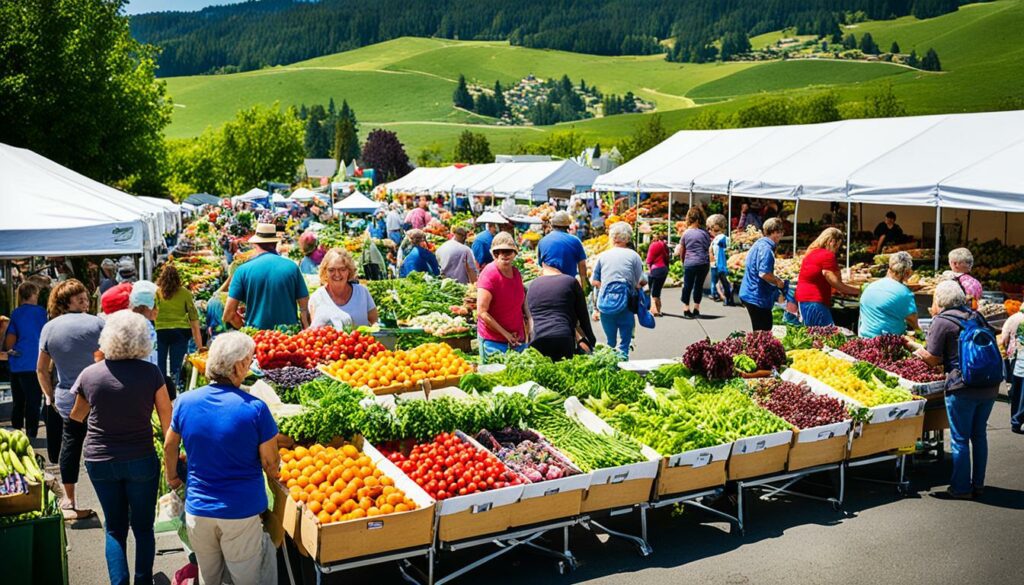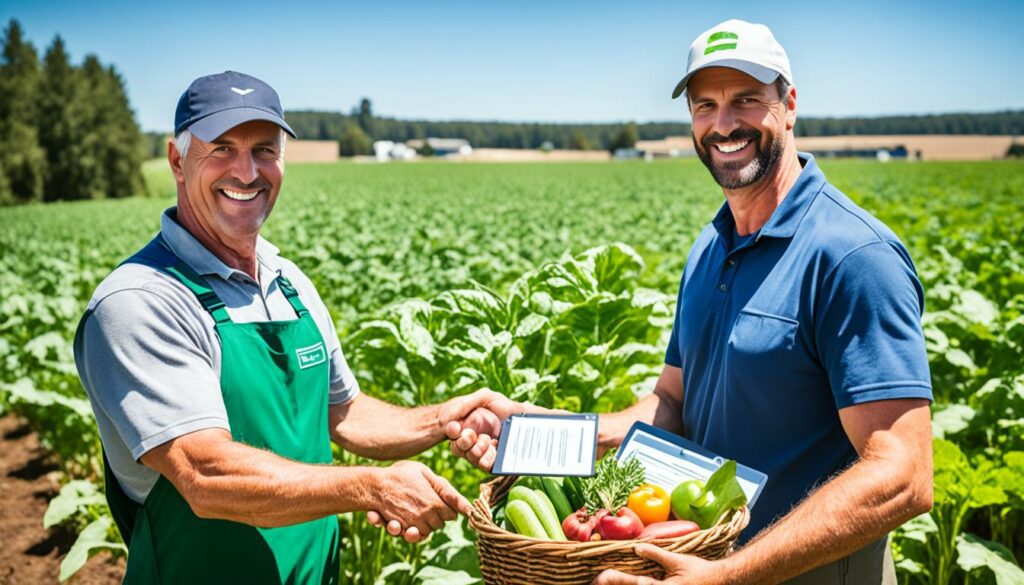Menu

Did you know the Economic Innovation Group found a big gap in 2017? They saw cities doing well, but countrysides falling behind. This problem made groups from all over come together. They wanted to help rural areas with plans focused on communities.
Building stronger communities often starts with a solid group of people. Take Tyrrell County and Fairfield in the U.S. In Tyrrell County, over 29 groups joined the Ecotourism Committee. This group boosted the local economy by highlighting natural areas and the county’s history. This shows that success in farming comes from working and caring for the same place together.
Understanding each other’s needs is key. Look at the UK’s North Pennines Tourism Partnership. Here, several places work together for better tourism, making sure land is protected. This way of working helps both big and small farms grow in a smart and steady way.
Modern farming weaves together big and small farms. This creates a patchwork where teaming up is key. Agricultural partnerships let farms combine their resources and skills, from tools to ways they sell their goods. This helps them all grow and makes their communities stronger.
Both big and small farms can work together in different ways. They might come together just for a project or form more official groups like cooperatives. These partnerships can help new farmers get started by sharing things like land and advice. They can try new ideas without huge costs, which can lead to their success down the line.
However, teaming up in farming isn’t always smooth. There can be arguments, problems with who gets what, and how money is shared out. To avoid these, everyone needs to talk openly and agree on what the partnership means for them.
| Advantages | Disadvantages |
|---|---|
| Pooling resources | Disputes among collaborators |
| Sharing infrastructure and equipment | Profit-sharing challenges |
| Access to broader markets | Personality conflicts |
| Collective marketing strategies | Liability for collaborators’ actions |
| Business networks and support | Lack of sole control |
Places like Tyrrell County and Fairfield are good examples of how working together helps. It shows that sharing resources and goals can lead to more money for everyone. This kind of teamwork makes the farming world strong, ready to face challenges, and succeed.
Rural cooperation in agriculture is now seen as vital for strong communities. It uses the special assets of each community and acknowledges the various people involved in farming. This way, plans can be made to fit the needs of every place.

Each rural area stands out because of its history, location, and resources. These things greatly affect how farming is done and how people work together. For example, in the past, many stores helped locals, forming close ties and making the community stronger.
When communities work together, they must look at what land and people they have. Things like land access and the number of workers matter a lot. Projects like incubator farms help new farmers by offering land and equipment. This makes starting farming easier and fair for all.
Another good idea is when farmers join to share their knowledge and tools, as seen at Copake Agricultural Center. They work together without formal agreements, sharing solutions and marketing tips. But, there can be problems, like disagreements on profits or personal clashes. To avoid these, a clear plan is needed.
In the end, making the most of what each community has, and aiming for common goals, leads to success in rural teamwork. Understanding the differences helps make projects strong and able to change where needed. This way, farming can be better for everyone involved.
Rural places are thriving thanks to new farming ideas. These come from working with others and combining resources. Big and small farms work together in agribusiness alliances to make big changes. They create an environment where new ideas grow and partnerships succeed.
Successful farm alliances need three key things. They should start with a clear goal and keep working together. They grow by finding new chances to succeed. These principles help build trust and a solid working relationship.
The 2024 Innovation Challenge is a great example. It’s offering over $10,000 in prizes for new ideas. Anyone can join before November 15, 2023, making it a global event for creative farmers.
California’s over 400 products show what great teamwork can do. Its farms work together, combining new methods with old. This fusion benefits everyone. Innovation meets tradition in these fruitful partnerships.
ICRISAT, with 50 years of breakthroughs, is another great story. It works with many groups to help dryland farmers. Their work meets the United Nations’ goals by fighting poverty and climate change. It’s all about supporting those who need it most.
| Initiative | Key Focus | Impact |
|---|---|---|
| 2024 Innovation Challenge | Agribusiness Innovation | Stimulates global farm innovation, offers cash prizes, supports all development phases |
| California Agricultural Collaborations | Effective Farm Alliances | Produces vast commodity range, fosters large-small farm cooperation |
| ICRISAT Partnerships | Successful Agricultural Collaboration | Enhances dryland agriculture, empowers small farmers, aligns with SDGs |
We can learn a lot from these alliances. They show how working together benefits all. By aiming for the same goals, trusting each other, and encouraging new thinking, farms ensure a bright and sustainable future.
Trust is the key to successful farm partnerships. It comes from working together towards common goals. In these partnerships, farmers combine their resources to improve their farms together.

Working together, farmers share what they’re good at, the tools they use, their buildings, and even their plans to sell what they produce. By working as a team, they make their farms better. So, different types of farms working together, each in their unique way, show us how trust grows.
But, it’s not always easy working with others. Problems can arise, like disagreements or not getting along. Yet, overcoming these challenges is what makes partnerships strong. By creating a supportive atmosphere, both big and small farms can connect like the Tyrrell County community.
Incubator farms stand out as places where new farmers get a leg up. Here, Spencer Blackwell’s story at Elmer Farm in Burlington, VT shines. He made his farm a success with help and advice from others.
Despite the difficulties, bringing farms of different sizes together can have huge benefits. It leads to a more efficient and caring farming world. Strong trust between larger and smaller farms is vital for farming’s success for everyone.
Bringing different farm groups together leads to big economic gains. Places like Tyrrell County show how using what’s close by can make money grow. This teamwork says a lot about the good effects on the *local agriculture impact* these groups bring.
Farming partnerships mix lots of people to help the area’s economy a lot. Take incubator farms, for instance. They give new farmers cheap access to land, tools, advice, and help with planning.
A good story is Spencer Blackwell’s. He started out at an incubator farm and then got Elmer Farm. This shows how these setups can really boost areas economically and make people more independent.
Over 500 million small farms worldwide produce a third of our food. These farms are really important for the money they bring in. The right *farming partnership economics* can make them even more valuable.
In farming partnerships, saving money together is a big plus. Partners share work, know-how, tools, and ways to sell their produce. This teamwork cuts costs and makes things more efficient.
In some places, farmers act like partners without making it official. They help each other out by sharing tools and their skills. This kind of sharing means big savings.
The Livelihoods Fund for Family Farming is boosting farmer incomes in Madagascar by 200%. It’s also saving land and plants. Projects like this show how working together can do a lot for farmers and their areas. They make things stronger and more sustainable for farmers all over.
Working together in farming has a big impact. It helps the farm develop ways to be eco-friendly and use resources wisely. Collaborative efforts can lead to eco-friendly farm projects that care for nature and keep the economy strong.

The SA Murray-Darling Basin stands out for its diverse types of farms. Collaborations here have proved important. Since 2017, groups in the Natural Resources SA Murray-Darling Basin have been looking at farming together. Their goal is to boost how much they produce, stay sustainable and enjoy a better life.
Joint farming efforts are great for saving resources. Say, grain growers who share machines can cut harvest time and save money. This means less waste. Sharing things like shearing sheds helps everyone use what’s available well. It improves how people work together and what they achieve.
Farming together means doing things that help the environment. For example, working with beekeepers to use beehives improves crops. This is a win-win. Other efforts, from sharing equipment to taking care of the land, show how everyone can benefit. It’s not just about making money, but about taking care of the earth we live on.
Exchanging work skills, using animals to maintain the lands, and shared equipment costs all help. These ways of working together are good for the pocket and for the planet. They help the community thrive in both money and environment.
Farming collaborations’ success depends on many factors, both inside and outside the group. Looking at 30 case studies in the EU, we see the key role collaboration plays in both the environment and the economy. For instance, in Tyrrell County, the Ecotourism Committee used the area’s natural and cultural beauty to make economic gains.
The initiative in North Pennines shows how working together in farming can solve local problems. It’s about sharing what people know and have to do more as a team. This lets them get more done, get better deals, and raise funds to keep farming in a way that’s good for the land. They learn to balance what’s good for the community and what’s good for making money, which is not always easy.
Tyrrell County shows how coming together for something like ecotourism can help in more ways than one. They use their natural beauty to get more visitors, which in turn helps the local economy. But it’s not just about selling pretty sights. It’s creating connections in the community and making the area better for everyone. This sort of project helps the area grow in many ways.
The North Pennines effort is another great example. Here, different groups work on farming and tourism together to keep the land healthy and the economy going. This way of working teaches everyone new things, lets them be more creative, and supports long-term farming goals. It’s a good model for other areas to follow.
on the factors influencing the success of collaborative groups in sustainable agriculture.
| Factor | Impact on Success |
|---|---|
| Actor-related Factors | Significant |
| Organization and Management-Related Factors | Significant |
| External Factors | Moderate |
| Initial Conditions | Less Crucial |
Comparing the stories of Tyrrell County and North Pennines highlights how important local factors are. They show that what the people in the group do matters more than outside things that they can’t control.
Rural working together often faces big hurdles. These include disagreements, who gets what, and personal issues. Luckily, there are ways to tackle these rural collaboration challenges to build strong, lasting partnerships.

Starting a cooperative effort involves dealing with fears together. Everybody coming together and understanding each other’s worries is key. This makes farmers work as one team, preparing the way for major solutions in farming cooperation. Starting off informally, like sharing skills and tools, helps without needing formal deals.
Keeping agricultural partnerships strong needs everyone to stay involved. Using methods like showing you’re trustworthy, being able to make decisions, and acting quickly is helpful. An example is how Tyrrell County worked with many others for green travel, which majorly helped their economy.
“Stakeholder engagement strategies addressing legitimacy, power, and urgency enhance collaboration efforts.” – Manzo and Perkins, 2006
Continuously sharing resources builds a tight network between partners. Farm incubators play a big part by offering things like land, tools, help, and plans for business growth. They show how much can be achieved through ongoing teamwork.
Rural places can get ahead by working together well, even when the city seems to pull ahead. Tyrrell County and North Pennines’ success stories teach us. They show that facing and fixing rural collaboration challenges can make our villages and towns prosper.
In farm collaborations, involving stakeholders is crucial for success. Look at areas like Tyrrell County and North Pennines. It shows planning well lets everyone help make the project succeed.
It’s key to have an efficient way to spot and engage stakeholders in farming projects. This step should look at how important, influential, and immediate each stakeholder is. Let’s see how recognizing these leaders and crafting a wide-reaching plan improves working together in farming.
For successful farm projects, it’s important to know the main stakeholders. This includes farmers, local businesses, governments, and non-profits. They should share the project’s main goals. In Lithuania, they found 14 groups could really help with farming. But, connections between them were not strong enough, which needs to improve.
Creating effective farm plans means using each stakeholder’s skills and goals. Public-private partnerships are vital for better local food systems. In Lithuania, there was a gap between what the local groups wanted and what they could do. This shows the need for planning that welcomes everyone. Using tech like blockchain improves how well we can track food safety and transparency.
| Key Factors | Current Challenges | Potential Solutions |
|---|---|---|
| Stakeholder Identification | Weak horizontal links, limited bargaining power | Mapping stakeholders’ interests, enhancing bargaining power through alliances |
| Inclusive Planning | Gaps in motivations and competencies | Training programs, technology adoption for transparency |
| Public-Private Partnerships | Lack of cooperation between sectors | Strengthening public-private relationships |
Too much food is wasted in the United States. Building strong, inclusive farm plans can help fight this waste. It also encourages people to play their part in farming. This leads to farming that is more sustainable and open to everyone. By tackling the known issues, farm projects can be successful and good for everyone involved.
Looking into new ideas for farming is key for its future. A top idea is collaborative farming. In this, farmers combine their resources to help each other. They share skills, knowledge, and even equipment. This way of working together greatly benefits all involved.

One easy way to do this is when neighbours come together. They freely share what they have without signing any legal papers. But, there are also more formal ways like forming a cooperative or partnership. Each way has its own good points and challenges. So, it’s wise for farmers to think about these before joining.
Incubator farms are another new step in farming. They help new farmers get started by providing land and equipment. They also offer training and help in selling produce. This support is great for anyone just getting into farming. Yet, there are limits, such as not choosing the exact land you’ll farm.
The 2024 Innovation Challenge also shows how important new tech is in farming. It offers over $10,000 for the best tech ideas for small farms. This contest is open from August 15, 2023, to November 15, 2023. The winners will be announced in February 2024 at the Small Farm Tech Expo in Madera, CA.
To sum up, new ways of working together in farming are crucial. By sharing resources and coming up with smart solutions, the farming world can grow stronger and overcome its issues.
Technology in agriculture is changing how farms of different sizes work together. It’s improving teamwork and making farms more productive. By 2050, we’re expecting 70% more food will be needed. This makes advanced farming methods crucial to meet the world’s food needs. Right now, 9.9% of people worldwide don’t have enough to eat.
The market for precision farming is set to hit $16.35 billion by 2028. This shows how important advanced farming methods are for better farming. For instance, Real-Time Kinematic (RTK) technology offers ultra-precise field maps. It helps improve soil health and crop growth. Bee Vectoring Technologies use bees to boost crop yields without hurting the planet. In the U.S. alone, bees add $20 billion to crop values.
A key to success in farming today is good communication in farm collaborations. Apps like Agworld, used by over 11,000 people each month, make work smoother. They help farmers make better choices. FarmHQ is also making a difference. It offers great returns and helps farmers work together better in real time.
Then, there’s farm management software, which is seeing a big growth. This tech provides useful info and makes farming more efficient. It aids in better communication in farm collaborations and supports green farming. For example, it can improve how water is used, which is critical for farming well.
Youthful farmers see technology as a way to do better with less guesswork. They’re optimistic about what technology in agriculture can achieve. Yet, there are worries about how this affects small farms and their traditional ways. It’s important to manage these issues for fair and broad progress in farming.
Agricultural joint ventures offer great chances for market growth. They have changed the way we look at farming. In 2010/11, a study showed that 185 groups worked together on 317 projects. Two-thirds of these were joint ventures, while the rest were owned fully. Such projects covered varied fields like farm supplies, grains, and oilseeds. This shows how farmers are being creative to grow their business.
Many of these group efforts used limited liability companies (LLCs). These give the tax benefits of partnerships and protect partners like corporations. The way these groups worked was also very diverse. For instance, 92 joint projects were with other cooperatives, 57 with non-cooperatives, and 26 mixed both. This mix shows how powerful agricultural joint ventures can be in opening up new markets by working together.
Working together also means sharing costs and getting better tools. It lets farmers use the latest technology and knowledge to improve. Plus, these ventures often encourage taking care of the land as they work. This not only helps the environment but boosts the business too. Investors like these projects for their returns and lower risks. This interest helps these joint ventures play a big role in the farming industry’s progress.
Working together, large and small farms can boost the economy. By sharing resources, they also help each other out. Together, they develop the community and find new ways to farm.
Partnerships are key to sharing knowledge and technology. They make farming more efficient and help it last for the future. By working together, they make the countryside stronger.
Rural areas bring their own unique stories and people. This helps create farming plans that fit just right. They use what makes them special to grow well and meet local needs.
For partnerships to work, everyone needs to share a common dream. Trust and sticking together are also vital. And of course, they must use new ideas to achieve success over time.
Building trust is about being honest and showing respect. It also means working towards the same goals. This helps make strong, long-lasting farming teams.
Teaming up boosts the local economy. By sharing resources and cutting costs, farmers do better. They compete well in the market together.
Working as one helps farms take care of the land. They protect nature and keep their surroundings green. This way, they farm in a way that lasts for years.
The Tyrrell County and North Pennines groups are great models. They link farming with local beauty to make money. They also work to save the nature that surrounds them.
Coming together can be hard because everyone is different. Keeping partners happy over time is also a challenge. But it works when they focus on what they all care about.
Stakeholders matter a lot, so picking the right ones is essential. Everyone should have a voice and really care about the project. This makes partnerships strong and successful.
New ideas include high-tech farming and clever use of land for homes and farms. These plans keep farming communities going strong.
Tech makes working together easier and more effective. It improves how people talk and plan, making farming smarter. This way, they achieve more by working as a team.
By coming together, farms can offer something new to the world. They use what’s special about their area to create fresh products. This opens doors to growth and new jobs in farming.